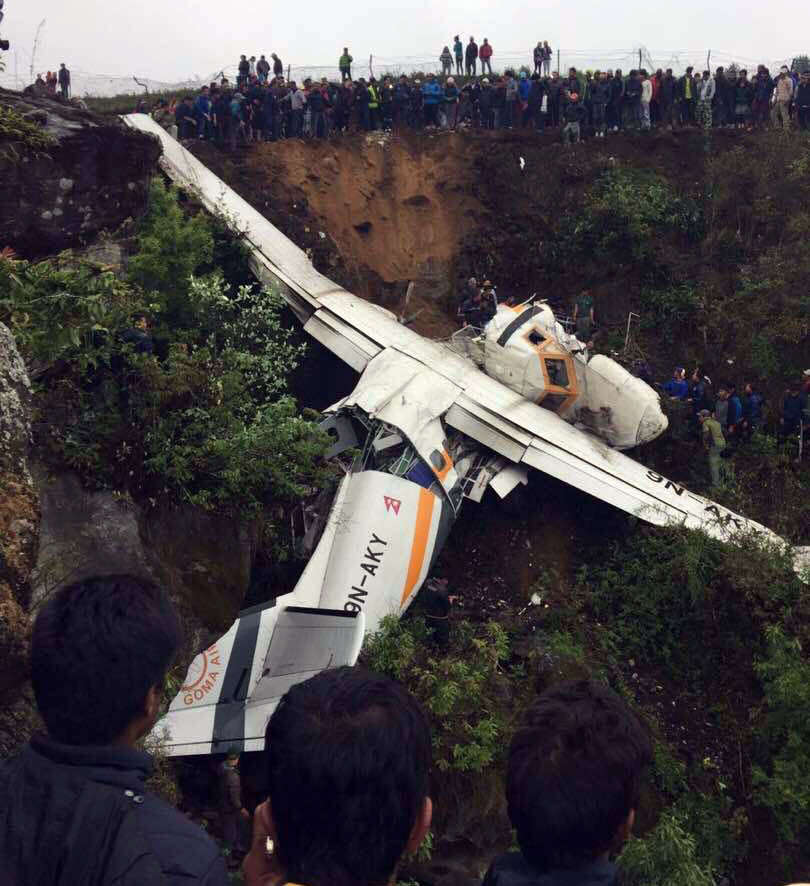Lukla airport lacks meteorological equipment
Kathmandu, June 12
The Himalayan Times’ investigation into the Goma Air Let-410 plane crash at Tenzing-Hillary Airport, in Lukla has revealed that one of the world’s most dangerous airports is being operated in a reckless manner that borders on sheer negligence, by both airline operators as well as the airport operator — Civil Aviation Authority of Nepal.
Flight operations to this precarious air strip still continues without providing the flight crew with critical information, including landing-threshold wind information, temperature, altimeter setting for the local atmospheric pressure, which is technically called the QNH, according to aviation officials. Though CAAN’s blacktopping of the steep up-sloping Lukla runway, over a decade ago with Asian Development Bank loans, lowered the maintenance expenses of airline operators, safety enhancements were not commensurate. On further inputs from ADB-appointed Japanese air safety consultants, it went on to install the APAPI visual glide slope indicator system in 2013, purportedly for enhancing safety. However, the anticipated benefits were never realised as the system was never commissioned. This daily had reported extensively on the issue in 2015 and yet no action had been taken against the culprits.
Bachchu Ram Shrestha, who relieved the incumbent airport chief at Lukla in the aftermath of the fatal crash, admitted that the airport has long operated without having any reliable meteorological equipment. Prior, Shrestha had been succeeded by previous airport chief a few months ago. The airlines have been merrily improvising -using the QNH from Kathmandu, a station that is a mile lower and involves different terrain and therefore flights are subject to serious altimetry errors. A difference of even 3-4 millibars can affect the safe landing vertical margins by over a hundred feet, a captain stated. "Had the aircraft been just 20 ft higher, it would have clearly made it," he added.
“It’s been already more than three years since the airport lacked reliable equipment to report the actual weather conditions,” he informed on phone from Lukla. According to him, CAAN has planned to install new meteorological equipment within a month. However, it is not clear if the equipment will meet the necessary criteria of the World Meteorological Organisation.
What is startling, though, is that no NOTAMS (Notice to Airmen) were ever issued to warn airline users about the hazardous deficiency, as is required by the provisions of International Civil Aviation Organisation on publication of aeronautical information. “And the flights loaded with tourists and cargo continued without any inquiries,” said Shrestha.
This not only raises serious questions about the business ethics of the airline but also the competence and sincerity of the CAAN air safety inspectors entrusted with the oversight of air carriers, a senior NAC captain said. Joint Secretary Suresh Acharya, also member secretary of the probe panel formed by the Ministry of Culture, Tourism and Civil Aviation, confirmed that the commission also received the ground reports, which indicate the serious lapses on handling of meteorological information at Lukla Airport. “We are thoroughly investigating its details,” Acharya said, adding the incident has also raised a serious question over CAAN’s oversight capabilities. The relieved airport chief and an air traffic controller have already been recalled to Kathmandu for administrative reasons, said a CAAN director. Interestingly, the air traffic controller on duty at the time of the crash was from a new batch who had flunked the recent Public Service Commission-administered CAAN recruitment exams, and had still been hired on contract, he revealed.
CAAN’s policy of hobnobbing with political masters, and thereby deputing green-horn tower personnel to unfamiliar and difficult airports, inexperienced in reading the treacherous Lukla weather, even during the peak climbing season, certainly contributed to the tragic loss, a senior pilot regretted.
READ ALSO:
- LETTERS: Goma Air crash
- Govt forms panel to probe Goma Air crash
- Senior captain dead, two hurt as Goma Air plane crashes in Lukla






